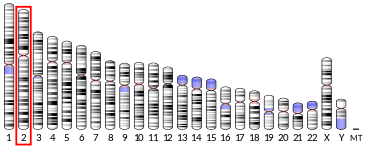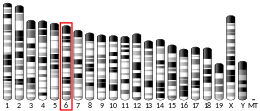Langerin
CD207, langerin (Cluster of Differentiation 207) is a protein which in humans is encoded by the CD207 gene.[5][6] Langerin is a type II transmembrane, C-type lectin receptor on Langerhans cells.[6][7]
Function
The protein encoded by this gene is expressed in Langerhans cells which are immature dendritic cells of the epidermis and mucosa. Additionally it is known by the name C-type lectin domain family 4 member K (CD antigen CD207). It is also expressed in several other dendritic cell types including dermal CD103+ DCs and splenic CD8+ DCs. Langerin is localized in the Birbeck granules, organelles present in the cytoplasm of Langerhans cells and consisting of superimposed and zippered membranes. It is a C-type lectin with mannose binding specificity, and it has been proposed that mannose binding by this protein leads to internalization of antigen into Birbeck granules and providing access to a nonclassical antigen-processing pathway.[5]
Clinical significance
Langerin on mucosal Langerhans cells of the human genital epithelium binds to HIV-1 and subsequently internalizes it into Birbeck granules to be degraded.[8][9]
See also
References
- GRCh38: Ensembl release 89: ENSG00000116031 - Ensembl, May 2017
- GRCm38: Ensembl release 89: ENSMUSG00000034783 - Ensembl, May 2017
- "Human PubMed Reference:". National Center for Biotechnology Information, U.S. National Library of Medicine.
- "Mouse PubMed Reference:". National Center for Biotechnology Information, U.S. National Library of Medicine.
- EntrezGene 50489
- Valladeau J; Ravel O; Dezutter-Dambuyant C; Moore K; Kleijmeer M; Liu Y; Duvert-Frances Vé; Vincent C; Schmitt D (2000). "Langerin, a Novel C-Type Lectin Specific to Langerhans Cells, is an Endocytic Receptor that Induces the Formation of Birbeck Granules". Immunity. 12 (1): 71–81. doi:10.1016/S1074-7613(00)80160-0. PMID 10661407.
- Valladeau J; Clair-Moninot Vé; Dezutter-Dambuyant C; Pin J-J; Kissenpfennig A; Mattéi M-G; Ait-Yahia S; Bates EEM; Malissen B (2002). "Identification of Mouse Langerin/CD207 in Langerhans Cells and Some Dendritic Cells of Lymphoid Tissues". Journal of Immunology. 168 (2): 782–92. doi:10.4049/jimmunol.168.2.782. PMID 11777972.
- De Witte L; Nabatov A; Pion M; Fluitsma D; De Jong MAWP; De Gruijl T; Piguet V; Van Kooyk Y; Geijtenbeek TBH (2007). "Langerin is a natural barrier to HIV-1 transmission by Langerhans cells". Nature Medicine. 13 (3): 367–71. doi:10.1038/nm1541. PMID 17334373.
- Turville S, Wilkinson J, Cameron P, Dable J, Cunningham AL (2003). "The role of dendritic cell C-type lectin receptors in HIV pathogenesis". Journal of Leukocyte Biology. 74 (5): 710–8. doi:10.1189/jlb.0503208. PMID 12960229.
Further reading
- Valladeau J, Dezutter-Dambuyant C, Saeland S (2003). "Langerin/CD207 Sheds Light on Formation of Birbeck Granules and Their Possible Function in Langerhans Cells". Immunologic Research. 28 (2): 93–107. doi:10.1385/IR:28:2:93. PMID 14610287.
- Quaranta MG, Mattioli B, Giordani L, Viora M (2006). "The immunoregulatory effects of HIV-1 Nef on dendritic cells and the pathogenesis of AIDS". The FASEB Journal. 20 (13): 2198–208. doi:10.1096/fj.06-6260rev. PMID 17077296.
- The Sanger Centre, The Washington University Genome Sequencing Center (1998). "Toward a Complete Human Genome Sequence". Genome Research. 8 (11): 1097–108. doi:10.1101/gr.8.11.1097. PMID 9847074.
- Valladeau J; Ravel O; Dezutter-Dambuyant C; Moore K; Kleijmeer M; Liu Y; Duvert-Frances Vé; Vincent C; Schmitt D (2000). "Langerin, a Novel C-Type Lectin Specific to Langerhans Cells, is an Endocytic Receptor that Induces the Formation of Birbeck Granules". Immunity. 12 (1): 71–81. doi:10.1016/S1074-7613(00)80160-0. PMID 10661407.
- Turville SG, Cameron PU, Handley A, Lin G, Pöhlmann S, Doms RW, Cunningham AL (2002). "Diversity of receptors binding HIV on dendritic cell subsets". Nature Immunology. 3 (10): 975–83. doi:10.1038/ni841. PMID 12352970.
- Strausberg RL, Feingold EA, Grouse LH, et al. (2002). "Generation and initial analysis of more than 15,000 full-length human and mouse cDNA sequences". Proceedings of the National Academy of Sciences. 99 (26): 16899–903. doi:10.1073/pnas.242603899. PMC 139241. PMID 12477932.
- Hunger RE, Sieling PA, Ochoa MT, Sugaya M, Burdick AE, Rea TH, Brennan PJ, Belisle JT, Blauvelt A (2004). "Langerhans cells utilize CD1a and langerin to efficiently present nonpeptide antigens to T cells". Journal of Clinical Investigation. 113 (5): 701–8. doi:10.1172/JCI19655. PMC 351318. PMID 14991068.
- Vashishta A, Fusek M, Větvička V (2005). "Possible role of procathepsin D in human cancer". Folia Microbiologica. 50 (1): 71–6. doi:10.1007/BF02931296. PMID 15954536.
- Gerhard DS, Wagner L, Feingold EA, Shenmen CM, Grouse LH, Schuler G, Klein SL, Old S, Rasooly R (2004). "The Status, Quality, and Expansion of the NIH Full-Length cDNA Project: The Mammalian Gene Collection (MGC)". Genome Research. 14 (10b): 2121–7. doi:10.1101/gr.2596504. PMC 528928. PMID 15489334.
- Verdijk P, Dijkman R, Plasmeijer EI, Mulder AA, Zoutman WH, Mieke Mommaas A, Tensen CP (2005). "A Lack of Birbeck Granules in Langerhans Cells is Associated with a Naturally Occurring Point Mutation in the Human Langerin Gene". Journal of Investigative Dermatology. 124 (4): 714–7. doi:10.1111/j.0022-202X.2005.23645.x. PMID 15816828.
- Bousarghin L (2005). "Human papillomavirus 16 virus-like particles use heparan sulfates to bind dendritic cells and colocalize with langerin in Langerhans cells". Journal of General Virology. 86 (5): 1297–1305. doi:10.1099/vir.0.80559-0. PMID 15831940.
- He B, Qiao X, Klasse PJ, Chiu A, Chadburn A, Knowles DM, Moore JP, Cerutti A (2006). "HIV-1 Envelope Triggers Polyclonal Ig Class Switch Recombination through a CD40-Independent Mechanism Involving BAFF and C-Type Lectin Receptors". Journal of Immunology. 176 (7): 3931–41. doi:10.4049/jimmunol.176.7.3931. PMID 16547227.
- Ward EM, Stambach NS, Drickamer K, Taylor ME (2006). "Polymorphisms in Human Langerin Affect Stability and Sugar Binding Activity". Journal of Biological Chemistry. 281 (22): 15450–6. doi:10.1074/jbc.M511502200. PMID 16567809.
- de Witte L; Nabatov A; Pion M; Fluitsma D; De Jong MAWP; De Gruijl T; Piguet V; Van Kooyk Y; Geijtenbeek TBH (2007). "Langerin is a natural barrier to HIV-1 transmission by Langerhans cells". Nature Medicine. 13 (3): 367–71. doi:10.1038/nm1541. PMID 17334373.
- Kaplan DH, Li MO, Jenison MC, Shlomchik WD, Flavell RA, Shlomchik MJ (2007). "Autocrine/paracrine TGF 1 is required for the development of epidermal Langerhans cells". Journal of Experimental Medicine. 204 (11): 2545–52. doi:10.1084/jem.20071401. PMC 2118472. PMID 17938236.
External links
- CD207 protein, human at the US National Library of Medicine Medical Subject Headings (MeSH)
- Overview of all the structural information available in the PDB for UniProt: Q9UJ71 (C-type lectin domain family 4 member K) at the PDBe-KB.





